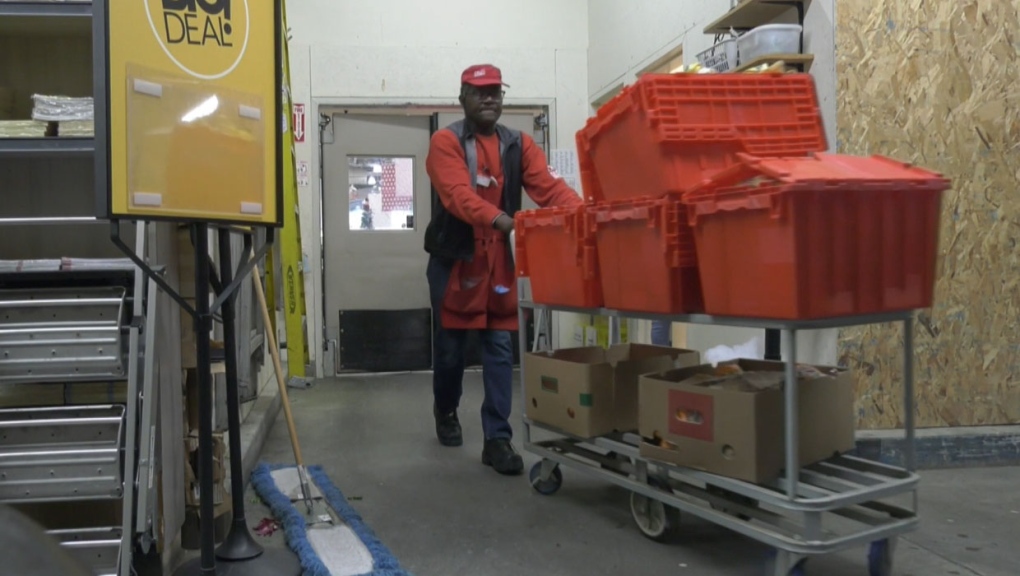Canadians cut back on groceries, while stores deal with the leftovers
Once a week, Becky Yeh makes dinner for her son.
The rest of the time, the Calgary senior is cooking for one.
"I cook only for myself so the choice is not much," she said as she loaded groceries into her car outside the Centre Street Safeway.
"Lunchtime is a salad and then at night it's only a small portion of fish and bowl of vegetables. I usually make fresh vegetables like broccoli, cabbage and cauliflower."
But like many other Canadians, Yeh is noticing how much more those vegetables cost.
In fact, pretty much all groceries are going up and people are struggling to cover that bill.
A new Nanos research poll says 61 per cent of Canadians are buying cheaper food, 25 per cent are stockpiling when they find deals and 17 per cent are simply eating less.
The survey asked more than 1,000 Canadians if their household had used a cost-saving option in the past month in response to the price of food.
"People don't have a lot of discretionary income," said Simon Somogyi, an expert in food business and retail at the University of Guelph. "They are trying to survive when everything is increasing so rapidly around them – prices increased by 11 per cent in the past 12 months."
That's also raising concerns about the potential for more waste.
Fresh food won't wait for people who can't afford it, meaning more may be thrown out at the store.
For the last year, staff at Calgary Co-op have spent every morning pulling all the food hitting its best-before date off the shelves.
It's then donated to local food banks, which are also seeing a growing demand.
"It's not only produce – it's also deli, frozen foods, dairy, meat, you name it," said Sage Pullen-Macintosh with Co-op.
"We are able to provide a lot of product – we just hit over a million pounds of food given to the food bank since we launched the program."

Sobeys/Safeway and Loblaws both have similar food surplus donation programs and other groups are also redirecting soon-to-expire produce.
Spud.ca users can buy the food at a deep discount while Loop Resource directs unsold food to local farms to feed animals.
In the meantime, Yeh says she found a way around paying more – she's eating less.
"When you get older, your appetite is not so big," she said. "I'm too old right now – I'm only eating small portions anyway."
METHODOLOGY
Nanos Research is a public opinion research firm.
Nanos conducted an RDD dual frame (land- and cell-lines) hybrid telephone and online random survey of 1,084 Canadians, 18 years of age or older, between Oct. 30 and Nov. 4 as part of an omnibus survey. Participants were randomly recruited by telephone using live agents and administered a survey online. The sample included both land- and cell-lines across Canada. The results were statistically checked and weighted by age and gender using the latest Census information and the sample is geographically stratified to be representative of Canada.
Individuals were randomly called using random digit dialling with a maximum of five call backs.
The margin of error for this survey is ±3.0 percentage points, 19 times out of 20.
This study was commissioned by CTV News and the research was conducted by Nanos Research.
Numbers may not add up to 100 due to rounding.
(With files from CTVNews.ca)
CTVNews.ca Top Stories

'Still working full time on it:' One year later police continue to search for gunman in Caledon double murder linked to ex-Olympian
One year after a couple was shot and killed in their Caledon home in what investigators have described as a case of mistaken identity, Ontario Provincial Police say they are still trying to figure out who pulled the trigger.
A man called 911 for help during a home invasion. Las Vegas police fatally shot him
A Las Vegas man called for police help during a home invasion before an officer fatally shot him, according to authorities and 911 calls.
Scurvy resurgence highlights issues of food insecurity in Canada's rural and remote areas
A disease often thought to only affect 18th century sailors is reemerging in Canada.
Lotto Max jackpot hits $80M for second time ever
The Lotto Max jackpot has climbed to $80 million for just the second time in Canadian lottery history.
'Very disturbing': Deepfake videos appear to target Canadian immigrants for thousands of dollars
Artificially generated videos of a Toronto-based lawyer asking for money appear to be just one way some try to exploit newcomers to Canada during a time of confusion around new immigration rules.
Nova Scotia Tories appear safe with close battle for second between Liberals and NDP
With two days left before Nova Scotians elect their next government, polls suggest Progressive Conservative Leader Tim Houston's decision to call an early vote will pay off and the real battle will be between the Liberals and NDP for second place.
Montreal police chief expects additional arrests following anti-NATO protest
Montreal's police chief says he expects more arrests stemming from a Friday anti-NATO protest that turned violent, with smashed windows and burned cars in downtown Montreal.
Cat caught in hunting snare rescued by BC SPCA
Donations are ramping up for a BC SPCA cat with a mangled paw after being caught in a hunting snare, one of a rising number of pets to fall prey to the hunting device.
'Wicked' and 'Gladiator' make gravity-defying theatre debuts
With a combined US$270 million in worldwide ticket sales, 'Wicked' and 'Gladiator II' breathed fresh life into a box office that has struggled lately.
































